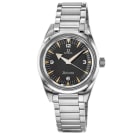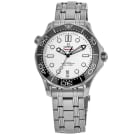How to Turn Estate Sale Finds Into a New Watch

Let’s be honest, there’s always a shiny new watch that you’ve got tucked away back in your mind as a dream purchase. Whether it’s a nice Longines watch, an Omega, or a pie-in-the-sky Rolex watch, you want it.
The trouble is that luxury comes at a price, and maybe it’s not the right time to make an investment like a high-end watch. Or, maybe it is and you just don’t know it yet.
Our trade-in program lets you turn old name-brand jewelry and watches into brand new luxury watches. Or at the very least reduce the price tag on a new watch.
“But I don’t have any jewelry or old watches that I want to part with,” you say? Well that’s where this next bit comes in handy.
Estate Sales and Hidden Treasures
Estate sales are a great way to find negotiably cheap furniture, art, electronics, and most relevantly, jewelry and watches.
The goal of estate sales is to sell it all. Kind of like a clearance event at a closing store location where everything must go. That means prices are often just a suggestion, and the longer you wait, the cheaper the seller will be willing to go.
Unfortunately, obviously valuable things like watches and jewelry will probably be some of the first things to go, so getting there as early as possible is the best bet. That doesn’t mean that some treasures won’t be overlooked, though.
Estate sales are a numbers game. They’re not all going to be worthwhile. In fact, most of them probably won’t. But some of them will be, and it’s all about persisting until you hit the jackpot.
Of course another challenge is being able to tell whether or not something is valuable.
How to Spot the Value
Most of us aren’t jewellers or really experienced in the art of authentication. And a lot of the time the leftover jewelry could maybe use a little polishing and cleaning up to really show off its true value. That’s okay, there are things to look for when you see a nice ring or watch at an estate sale.
The first thing you want to look for is a brand name or identifier. Especially with the Jewelry, as we don’t really accept trade-ins unless it’s associated with a brand name. With watches, this is easy. The brand will be displayed on the dial or somewhere on the watch’s case. If the watch says “Cartier” on it, you’ve hit paydirt with Cartier watches.
With jewelry, it can be a little tougher. Somewhere on the piece, whether it’s a ring, a necklace, or a bracelet, there will be a maker’s mark that signifies the branding. Depending on the size of the item, this can be a little difficult to discern, and you might need to have it appraised first.
But now you’re wondering how you can feel safe buying the jewelry if you can’t even tell the brand. Well, also stamped into the metal will be the quality of the material it’s made out of. For instance, a 14 karat gold necklace will have a stamp on it somewhere that says 14K. If the stamp says GP, GEP, RGP, or HGE, it’s gold plated and not worth your time.
Another trick is to carry a small magnet with you. Gold isn’t magnetic, you see. So if the jewelry sticks, it’s time to quit.
Trade In, Trade Up
Once you’ve hit up a few estate sales and amassed your little pile of treasures and watches, it’s time to turn those goodies into your new watch.
Take pictures of the items you’re trading in and head over to the “TRADE-IN” section of our site. Here, you’ll see a form to enter information about your watches and jewels and attach some pictures. After you’ve submitted the information, our specialists will have a look and get back to you with a list of what we’ll take and some rough estimates of the value.
After you send in your trade-ins, you’ll receive credit towards a new watch from our site. Heck, maybe you’ll be able to afford one without paying an extra cent!
It’s a great way to get what you want on your wrist faster and without spending as much. For more information on our trade-in process, visit the page for a step-by-step walkthrough.









